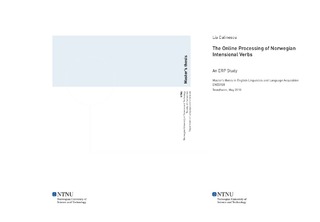| dc.description.abstract | The properties of language that allow us the freedom of stepping outside the world of facts into an almost infinite number of possible worlds, where things are how they could be, how they should be and how we hope and imagine them to be, are still unsolved puzzles that have captured the fascination of philosophers and linguists for centuries. Modality is one such property and the more common and natural it is in our everyday speech, the more complex and difficult to formally describe it becomes when placed under the scrutinizing inspection of scholars. Indeed, as many other aspects of language that seem so intuitive to us and which the brain achieves with incredible speed and efficiency, semantic modality has proven to hide many complicated layers of meanings when studied up close. Through this study we have tried to capture a glimpse of the brain’s activity while engaged in the processing of Norwegian modal verbs which quantify the speaker’s/subject’s degree of certainty that certain possible worlds coincide with the factual world. We conducted an EEG experiment that pits the semantics of modal verbs against what is commonly known about the world (“John dreams/imagines that birds have wings/ gills”), and asked whether Norwegian intensional modal verbs of imagination like “å drømme” (“to dream”) and “å innbille seg” (“to imagine”) are processed fully and incrementally during online comprehension in a way that affects the downstream processing of upcoming words as indexed by the N400 event related potential. The results point towards the fact that these verbs are processed incrementally and can affect the processing of upcoming words as no N400 effect was observed for typical (“wings”) versus atypical (“gills”) words in the context of either “innbille seg” or “drømme.” The fact that a strongly counterfactual verb like “innbille seg” did not cause a larger N400 response for typical versus atypical words, may suggest however that the full semantic meaning of this verb may not impact processing fast enough in order to override lexical-semantic associations between words and reverse the N400 effect. | nb_NO |
